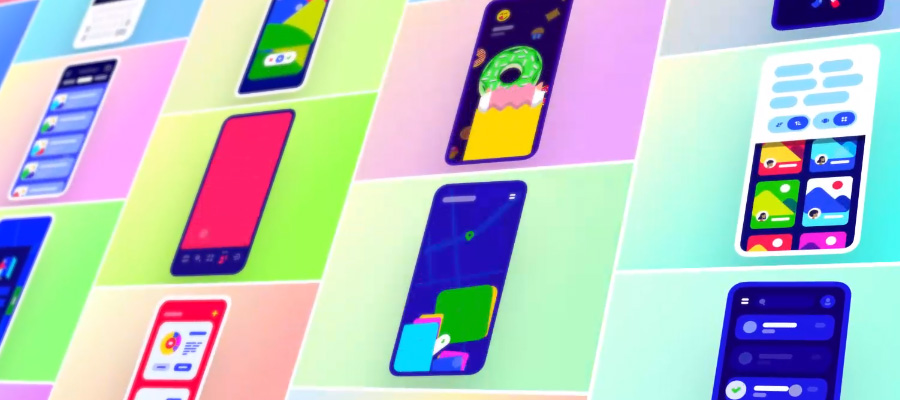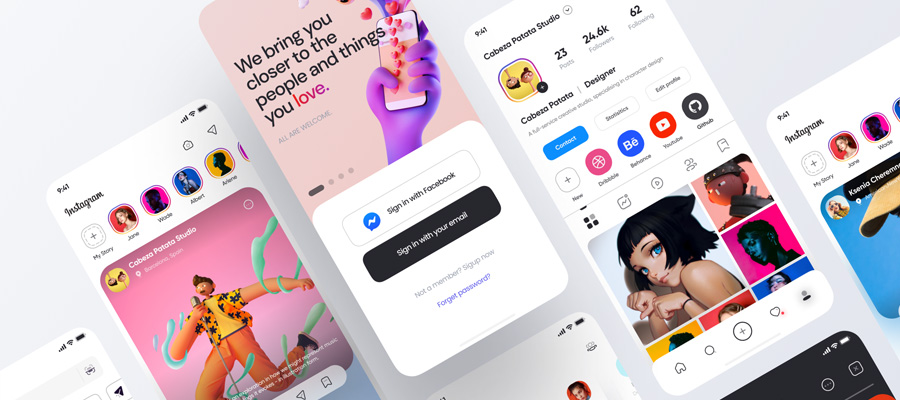Did you know that 10 unicorn companies valued at $1 billion and above are social media networks? From a business perspective, social media is a lucrative market to tap into. Sure, it already has established players to compete with, yet there’s still room left for the newcomers.
Building a social media application that stands a chance today means finding a specific niche for it. For instance, Snapchat originally targeted Gen Z and Gen Y users, tired of public peer shaming and parental surveillance on Facebook. LinkedIn created a professional networking community online. CityHour app took the same concept and turned it into a location-based networking app for entrepreneurs. Wanelo app blends in the social and shopping experience together.

SOCIAL MEDIA UI KIT by Julia Shagofferova
So before approaching social media app development make sure you have a somewhat established product concept in mind.
Where To Start If You Want To Develop a Social Media App From Scratch?
For a startup, Rocket Lab suggests the first step is to research their target audience and test the initial product assumptions with the actual users. You want an app that is intuitive, engaging and interests the potential users, right? After all, your revenues and future income will depend on those factors
Besides, the cost to build a social networking app is quite high. Here are the approximate cost estimates different social media development companies provided for popular networks:
- Pinterest clone - $120,000
- Snapchat-like app - $75,000 – $150,000
- Instagram clone - $100,000 – $300,000
- Vine – $125,000 - $175,000
The price will also change depending on whether you want an iOS app only, or an Android version as well. For instance, Instagram launched as an iPhone app only as the gadget featured a better camera at that point.
So, before going all in and paying the top price to social media app developers, you may want to validate your app idea with the actual audience and build a simple MVP opposed to a full featured product.
The 4-Step Plan For Social Media App Development
We prefer to follow the next blueprint for social media app development:
Strategy and Product Requirements Analysis
Before the developers start the job, we prefer to sit down together with the product owner and map out the entire app strategy. That includes drawing the complete predictive user persona, analyzing the competition and the market, exchanging ideas on design, custom features and technology to use for the project. We always proactively help to scale app features in terms of user value/importance for an MVP and outline where to save some dollars without compromising the overall app quality.
As a result, both parties agree on a detailed product requirements list and the respective development price.
Here’s a quick summary of the key features for a social media app:
- Profile creation: the easiest option is to offer integration and contact import from other social networks e.g. Facebook/Twitter/LinkedIn etc.
- Profile customization aka making your profile look unique by adding a custom background, information, profile picture and other content.
- Newsfeed aka where all the fun and interactions happen.
- Network relationships – ways to connect with others, follow/befriend users, invite current contacts etc. Users will only stay active within an app when they have friends to interact with.
- Content sharing/curation – all social media networks allow sharing content in one way or another. It could be video, gifs, text or photo updates. They can be anonymous, permanent or temporary.
- Messaging functionality – again, there are multiple ways to organize interactions.
UX and UI Design
Each product goes through the following design stages:
- Sketching: a pencil and paper version of the key screens and information architecture.
- Wireframing/Prototyping – a more advanced, often interactive version of your app, which could be shown to potential users and/or investors.
- App Skins design – the initial wireframes are transformed into the design itself.
Development
You'll need two teams on the project – the frontend guys to code all the cool app features and the backend guys to complete the server-side of your project.
Your social media app should be connected to a powerful database to handle the possible user load (what if you get 1 million users in the first year?). The best option for handling structured data, in this case, is to opt for a MySQL or PostgreSQL database. To process in-app relationships and in-app dynamic data, however, it’s better to choose a noSQL database like MongoDB.

Social Media Mobile App-UX/UI Design by Hira Riaz
Additionally, you will need a separate admin panel for your app to gather and manage different kinds of user analytics, offering customer support and control/manage user generated content if required.
Quality Assurance
We prefer to run Q&A tests continuously during the development process after each sprint is completed to make sure that all the product modules function seamlessly together. Depending on the project, we usually run a mix of manual and automated test cases, sometimes with the help of agency tools.
In a nutshell, that's how to make a social media app. For the geekier types, here are some additional insights on the tech stack used for the most popular social networking apps:
Instagram:
- Development language – Python
- Cloud storage – Amazon S3
- Web servers – NGINX
- Databases - Memcached, Cassandra, and PostgreSQL
- Beta testing – Testflight
Pinterest:
- Development languages – Java and Python.
- Main framework – Django.
- Web servers – Nginx
- Databases – Hbase, MySQL, Memcached, Hadoop
- In-memory database – Redis.
- Content delivery – Edgecast
Snapchat:
- Development languages – Python, Ruby, Java and PHP
- Cloud hosting – Google Computer Engine
- Front-end frameworks – Bootstrap, Semantic UI
- Full-stack framework – Cocoa Touch.
Of course, these are just some of the technologies used to develop these social media unicorns and you shouldn’t limit yourself to those either. Consult with the experienced developers to get a better idea of how such project could be implemented for your company.




















